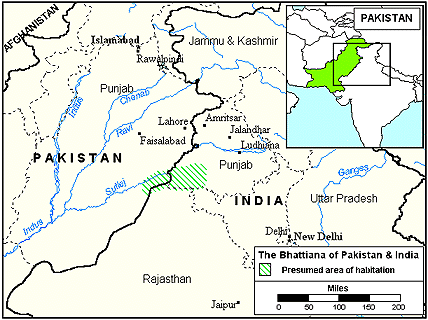|
|
Prayer Profile
The Bhattiana of Pakistan
![[IMAGE]](../images3/0531.jpg) Pakistan is a land characterized by great geographic, climatic, linguistic, religious, and ethnic diversity. With a population of nearly 140.5 million, it is home to more than 90 distinct ethnic groups, with the major ones being the Punjabi, Sindhi, Pathan, and Urdu. This varied ethnological background is largely a result of repeated invasions during Pakistan's long history. The people come from such varied ethnic backgrounds as the Dravidian, Indo-Aryan, Greek, Scythian, Hun, Arab, Mongol, Persian, and Afghan.
Pakistan is a land characterized by great geographic, climatic, linguistic, religious, and ethnic diversity. With a population of nearly 140.5 million, it is home to more than 90 distinct ethnic groups, with the major ones being the Punjabi, Sindhi, Pathan, and Urdu. This varied ethnological background is largely a result of repeated invasions during Pakistan's long history. The people come from such varied ethnic backgrounds as the Dravidian, Indo-Aryan, Greek, Scythian, Hun, Arab, Mongol, Persian, and Afghan.
Scattered throughout Pakistan and often intermingled with the larger ethnic groups are many smaller groups, one of which is the 14,100 Bhattiana. They are located in the northeastern part of the nation, south of Islamabad. They speak a language called Bhatneri, which is a part of the Indo-Aryan language family. Very little specific detail is known concerning the lifestyle and culture of the Bhattiana.
What Are Their Lives Like
The division of the subcontinent of India in 1947 caused tremendous dislocation of populations. Some 3.5 million Hindus and Sikhs moved from Pakistan into India, and about 5 million Muslims migrated from India to Pakistan. This shift caused an initial bitterness between the two countries, further intensified by each country's acquisition of a portion of the princely states.
About 26% of Pakistan's land is suitable for farming, with most of that land being irrigated. Agriculture and related activities engage about half of the work force, and more than 65% of the people live in rural areas. Agricultural yield has been low because of the large number of sharecroppers who have little incentive to increase production. In an attempt to deal with the problem, reform and progressive taxes have been introduced. In the 1960's and 1970's, wheat production dramatically increased, due to the use of improved strains. These increases enabled Pakistan to become agriculturally self-sufficient, though there are still occasional shortages.
Wheat is the staple crop, and sugarcane is widely grown. Cotton and rice are the major export crops. The number of livestock per person is high, but the production of meat and milk remains low because of inadequate feed and poor management. Goats and sheep are the most numerous animals, followed by cattle, buffalo, and camels.
Family organization is patriarchal (dominated by the males), and most people live in large extended families. A woman's place in society is low, and she is restricted to domestic chores and to fulfilling the role of a dutiful wife and mother. Social structure revolves around kinship rather than caste. Beradari (tracing ancestry through the males) is the most important social institution. Men prefer to marry the daughters of their fathers' brothers; thus, among many groups, marriages are invariably within the beradari. The elders of a lineage constitute a council that settles disputes and represents the lineage to the outside world.
What Are Their Belief?
The dominant religion of Pakistan is Islam, which is embraced by about 97% of the people. Hinduism and Christianity form the leading minority religions. The Bhattiana are included in the majority group, being 99% Muslim. The Pakistani constitution defines the country as an Islamic nation but guarantees freedom of religion. In reality, however, there is much persecution of Christians.
What Are Their Needs?
Only about 35% of adult Pakistanis are literate. The constitution provides for five years of free primary education, but less than half of all children actually receive it. In addition, birth and death rates are high. The government has unsuccessfully attempted to lower fertility levels by encouraging female employment and family planning.
The Bhattiana have the New Testament in their own language, but there are no missions agencies currently targeting them. A great need for intercession and missions efforts still remains if the Bhattiana are to come to Christ.
Prayer Points
- Ask the Lord to soften the hearts of Pakistan's leaders towards the preaching of the Gospel.
- Pray that Christian teachers will respond to the challenge of sharing their skills and their faith with the Bhattiana.
- Pray that the Jesus film and Christian radio broadcasts will be made available to the Bhattiana.
- Ask the Lord Jesus to reveal Himself to the Bhattiana through dreams and visions.
- Pray that signs and wonders will follow the Bhattiana believers as they share Christ with their own people.
- Take authority over the spiritual principalities and powers that are keeping the Bhattiana bound.
- Ask God to call faithful intercessors who will stand in the gap for the Bhattiana.
- Ask the Lord to bring forth a triumphant Bhattiana church for the glory of His name!

Statistics
Latest estimates from the World Evangelization Research Center.
THE PEOPLE
- People name: Bhattiana
- Country: Pakistan
- Their language: Bhatneri
- Population:
- Largest religion:
- Christian: 1%
- Church members: 141
- Scriptures in their own language: New Testament
- Jesus Film in their own language: None
- Christian broadcasts in their own language: Noen
- Mission agencies working among this people: 0
- Persons who have heard the Gospel: 3,100 (22%)
- Persons who have never heard the Gospel: 11,000 (78%)
THEIR COUNTRY
- Country: Pakistan
- Population:
- Major peoples in size order:
- Major religions:
- Number of denominations: 37
© Copyright 1997
Bethany World Prayer Center
This profile may be copied and distributed without obtaining permission
as long as it is not altered, bound, published
or used for profit purposes.
![[HOME BUTTON]](../graphics/home.jpg)
![[CALENDAR BUTTON]](../graphics/calico.jpg)
![[LIST BUTTON]](../graphics/listico.jpg)
[Home]
[Calendar]
[Country List]
|